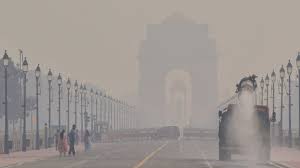The air quality across Delhi, Noida, and Ghaziabad has worsened to alarming levels, prompting authorities to implement GRAP-3 (Graded Response Action Plan – Stage 3). The move comes as pollution levels rise above the AQI 400 mark, severely affecting air quality in several parts of the National Capital Region.
According to the Commission for Air Quality Management (CAQM), the decision was taken after pollution levels surged in areas such as Anand Vihar, Palam, Red Fort, and Chandni Chowk. The air quality index in Delhi jumped from 362 (very poor) on Monday to 425 (severe) on Tuesday, mainly due to stagnant winds and unfavorable weather conditions.
What Restrictions Are Imposed Under GRAP-3?
With the implementation of GRAP-3, several stringent restrictions have been enforced to curb emissions and reduce pollution:
- Construction and Demolition Ban: All non-essential construction and demolition activities are prohibited.
- Old Diesel Vehicles Prohibited: Diesel vehicles, especially those with BS-4 engines or older, are banned from operating in Delhi.
- Ban on Goods Transport Trucks: Trucks carrying construction materials such as sand, cement, and bricks are not allowed to enter Delhi.
- Ban on Diesel Buses: Diesel-run buses from both within and outside Delhi are prohibited.
- Closure of Primary Schools: Schools up to Class 5 may remain closed; online classes are advised as an alternative.
- Ban on Stone Crushers and Mining: Operations of stone crushers and mining activities are suspended.
- Diesel Generator Ban: Diesel generators are banned except for emergency and essential services.
- Work-from-Home Advisory: Offices and companies have been asked to operate remotely or in hybrid mode to reduce vehicular pollution.
Understanding the GRAP Stages and AQI Levels
The Graded Response Action Plan (GRAP) outlines specific measures based on the Air Quality Index (AQI) levels:
- GRAP-I: Implemented when AQI is between 201–300 (Poor)
- GRAP-II: Enforced when AQI is between 301–400 (Very Poor)
- GRAP-III: Activated when AQI ranges from 401–450 (Severe)
- GRAP-IV: Applied when AQI exceeds 450 (Very Severe)
Last year, GRAP-3 was also imposed in mid-November following a similar pollution spike across the region.
NCR Districts Under GRAP-3 Restrictions
The National Capital Region (NCR) includes 24 districts, covering parts of Delhi, Haryana, Uttar Pradesh, and Rajasthan.
Delhi: 11 districts (including Central, East, New Delhi, North, North East, North West, Shahdara, South, South East, South West, and West Delhi).
Haryana (14 districts): Faridabad, Gurugram, Nuh, Rohtak, Sonipat, Rewari, Jhajjar, Panipat, Palwal, Bhiwani, Charkhi Dadri, Mahendragarh, Jind, and Karnal.
Uttar Pradesh (8 districts): Meerut, Ghaziabad, Gautam Buddha Nagar (Noida), Bulandshahr, Hapur, Baghpat, Shamli, and Muzaffarnagar.
Rajasthan (2 districts): Bharatpur and Kotputli-Behror.
Previous Measures and Efforts to Combat Pollution
The Delhi government has already banned vehicles with BS-4 engines to reduce vehicular emissions. In addition, an attempt was made to induce artificial rain through cloud seeding, though it did not yield successful results.
Authorities continue to monitor the situation closely and may escalate to GRAP-4 if the AQI exceeds 450, which would bring even stricter curbs across the NCR.














